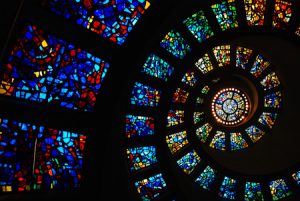 Certain colors are associated with certain things. When you think of green, what comes to mind? Nature? Money? How about blue? Water/the ocean? Red? Warnings? Stop Signs? Indeed, different colors help communicate different ideas, emotions and things. This is true for colors in stained glass windows, too.
Certain colors are associated with certain things. When you think of green, what comes to mind? Nature? Money? How about blue? Water/the ocean? Red? Warnings? Stop Signs? Indeed, different colors help communicate different ideas, emotions and things. This is true for colors in stained glass windows, too.
Take, for instance, the many beautiful stained glass windows used in “houses of worship” in places like the U.S., Europe and Israel. From churches to mosques to synagogues, there are stained glass windows that are used to communicate ideas to all those who see and experience them. These aren’t plain, monochromatic windows, either. These are diverse and oftentimes brilliant windows with elaborate scenery and characters imbued with meaning.
With regards to religious stained glass, what’s the significance and/or symbolism behind the usage of certain colors? For the purpose of this article, we’ll consider stained glass color symbolism from a Christian perspective, since it’s predominant over much of the world.
Red
The color red, for example, is typically representative of the blood of Jesus Christ. The color red may be associated with strong emotions such as hate, or, better yet, love. It can serve as a reminder of Jesus’ suffering and sacrifice on the cross.
Purple
The color purple (or violet) is often the color of royalty. It can symbolize not only suffering (as an offshoot of red), but also truth, love, passion and leadership.
Blue
Blue is typically associated with the Virgin Mary. It can symbolize sincerity, piety and hope. It can also help show scenes where the sky and/or heaven is prominent.
Green
From looking above to looking below, we go on to the color green– the color of grass and nature. Green is used as a symbol of spring, rebirth, and growth; it’s associated with life over death.
White
What about white? In stained glass, white helps show innocence, purity and chastity. Gray, an offshoot of white, can represent the immortality of the spirit, as well as mourning and/or humility.
Black
Black, which might be the color of the lead around stained glass, isn’t typically seen in stained glass windows themselves, unless the creator wants to symbolize death or regeneration. Brown, which is close to black, can symbolize spiritual death and the giving up of worldly things (think of monks and their brown cloaks).
Yellow
Yellow is typically used in religious stained glass for halos around saints, or to show the Gates of Heaven. Yellow can symbolize divinity, power, glory, and even treachery (in the case of Judas’ betrayal of Jesus).
Rainbow
Finally, there’s the rainbow. If you see a rainbow in stained glass, it symbolizes the union and God’s covenant with humanity. In more recent times, it might also indicate that the congregation is gay-affirming.
The next time you visit a house of worship, take some time to examine the colors used in the scenes you see in their stained glass windows. Colors help tell the stories those windows are trying to communicate.
If you need a stained glass window installed, repaired or fabricated, contact Cumberland Stained Glass Windows today.
